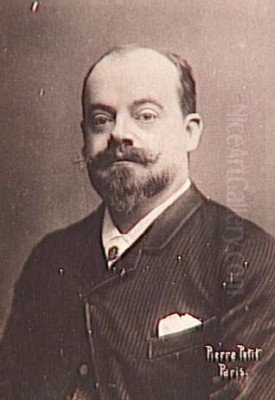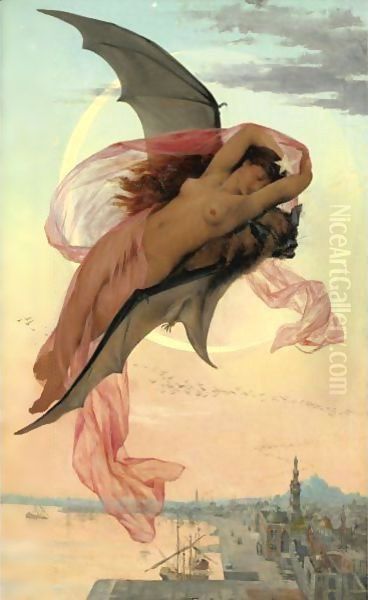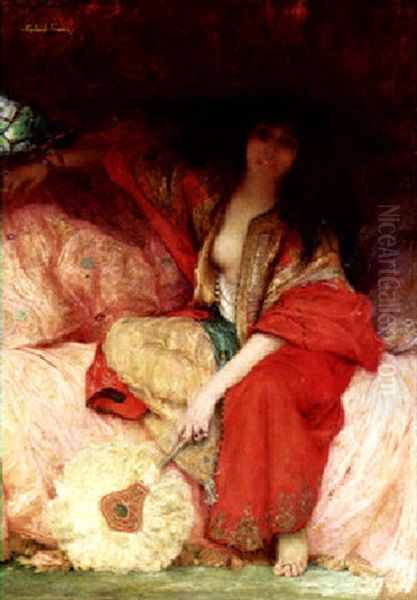
Gabriel Joseph Marie Augustin Ferrier (1847-1914) stands as a significant, if sometimes overlooked, figure in the landscape of late 19th and early 20th-century French art. A product of the rigorous academic tradition, Ferrier carved out a distinguished career as a painter of portraits, historical scenes, and captivating Orientalist subjects. His work, characterized by technical finesse and an elegant sensibility, earned him numerous accolades, including the prestigious Prix de Rome, and a respected position as an educator who influenced a new generation of artists, most notably Henri Matisse. This exploration delves into the life, art, and enduring, albeit quiet, legacy of a painter who navigated the shifting artistic currents of his time with skill and dedication.
Early Life and Artistic Formation in Paris
Born in Nîmes, in the South of France, on September 29, 1847, Gabriel Ferrier's upbringing in a family where his father was a pharmacist did not initially point towards an artistic career. However, an early passion for drawing and painting soon became evident. This burgeoning talent led him to Paris, the undisputed center of the art world in the 19th century, to pursue formal training at the renowned École des Beaux-Arts. This institution was the bastion of French academic art, emphasizing mastery of drawing, anatomy, perspective, and the study of classical and Renaissance masters.
At the École, Ferrier had the privilege of studying under influential figures such as Ernest Hébert (1817-1908) and Isidore Pils (1813-1875). Hébert, himself a Prix de Rome winner, was known for his melancholic Italian genre scenes and elegant portraits, often imbued with a subtle romanticism. Pils, also a Prix de Rome laureate, was celebrated for his military scenes and religious paintings, executed with a robust realism and dramatic flair. Under their tutelage, Ferrier honed his technical skills, absorbing the academic emphasis on meticulous draftsmanship, balanced composition, and a polished finish. The environment at the École was highly competitive, with artists like Jean-Paul Laurens and Fernand Cormon also emerging from this system, striving for recognition through the official Salon.
The Coveted Prix de Rome and Italian Sojourn

Ferrier's talent and dedication quickly bore fruit. His official career commenced with his debut at the Paris Salon in 1869, the primary venue for artists to exhibit their work and gain public and critical attention. The Salon system, though increasingly challenged by avant-garde movements, remained a powerful arbiter of taste and success. For an aspiring academic painter, recognition at the Salon was paramount.
A pivotal moment in Ferrier's early career arrived in 1872 when he was awarded the prestigious Prix de Rome for painting. This highly coveted prize, established in the 17th century, granted the winner a scholarship to study at the French Academy in Rome, housed in the Villa Medici. Ferrier's winning entry was a dramatic historical painting, reportedly depicting a scene from a deluge, showcasing his mastery of complex figural composition and emotive narrative, qualities highly valued by the Academy. Other notable Prix de Rome winners in painting around this period included Luc-Olivier Merson and Édouard Toudouze, highlighting the caliber of artists Ferrier was associated with.
From 1873 to 1876, Ferrier immersed himself in the artistic riches of Rome. This period was crucial for his development, allowing him to study firsthand the masterpieces of antiquity and the Renaissance. The Italian sojourn often inspired artists to tackle grand historical or mythological themes, and Ferrier was no exception. During his time in Rome, he continued to refine his style, absorbing the classical influences that would underpin much of his later work. It was also a period where he began to explore themes that would become recurrent in his oeuvre.
Return to Paris: Portraits and Salon Success
Upon his return to Paris in 1876, Ferrier established himself as a prominent figure in the city's vibrant art scene. He became a regular exhibitor at the Salon, where his works were generally well-received. While he continued to produce historical and genre paintings, he increasingly focused on portraiture. In an era before the widespread adoption of photography for formal likenesses, painted portraits were highly sought after, particularly by the burgeoning bourgeoisie and political figures of the French Third Republic.

Ferrier excelled in this genre, creating elegant and insightful portrayals of notable personalities. His portraits were praised for their technical skill, psychological acuity, and sophisticated presentation. He captured not only the likeness of his sitters but also a sense of their character and social standing. His contemporaries in the field of academic portraiture included masters like Léon Bonnat and Carolus-Duran, whose success set a high bar. Ferrier's ability to secure commissions from prominent individuals associated with the Third Republic attests to his reputation and the esteem in which his work was held. These portraits served as important visual documents of the era's leading figures.
His Salon submissions continued to garner acclaim. The academic tradition, championed by artists like William-Adolphe Bouguereau and Alexandre Cabanel, still held considerable sway, and Ferrier's polished technique and appealing subject matter resonated with the Salon juries and the public. He navigated the expectations of the Salon adeptly, producing works that were both technically accomplished and accessible.
The Allure of the Orient: Ferrier's Orientalist Works
A significant development in Ferrier's artistic trajectory occurred in 1883 when he embarked on a journey to Algeria. This voyage immersed him in the landscapes, cultures, and peoples of North Africa, providing a rich new vein of inspiration that would lead to some of his most celebrated works. Like many European artists of his time, including Eugène Delacroix, Théodore Chassériau, Jean-Léon Gérôme, and later, Étienne Dinet and Gustave Guillaumet, Ferrier was captivated by the "Orient"—a term then used to describe regions of North Africa, the Middle East, and sometimes further afield.
Orientalism in art often involved depicting exotic scenes, vibrant costumes, and what were perceived as the traditional ways of life in these regions. Ferrier's Orientalist paintings are characterized by their luminous color palettes, attention to ethnographic detail, and often, a romanticized vision of North African life. Works such as Young Algerian Shepherdess exemplify this aspect of his oeuvre. These paintings were immensely popular with European audiences, offering a glimpse into seemingly distant and enchanting cultures.
One of his notable Orientalist paintings is Les Fumeurs De Kiff (The Kiff Smokers), dated 1887. This work likely depicts a scene of men partaking in kief, a cannabis product, a subject that combined exoticism with a hint of the transgressive, appealing to certain Western sensibilities of the time. Another significant piece, La Favorite Parfumée (The Perfumed Favorite), from 1877, though predating his Algerian trip, already shows an inclination towards Orientalist themes, blending academic figure painting with the sensuous allure associated with harem scenes, a popular subgenre within Orientalism. These works contributed significantly to his fame and placed him among the respected Orientalist painters of his generation.
Decorative Commissions and Public Art
Beyond easel painting, Ferrier also undertook large-scale decorative commissions, a testament to his versatility and the high regard in which his skills were held. Such projects were prestigious and allowed artists to work on an ambitious scale, often integrating their art into significant architectural spaces. The provided information mentions his involvement in creating murals for the French Embassy in Berlin and for the Louvre Palace in Paris.
These decorative works would have required not only artistic skill but also the ability to work collaboratively and to adapt his style to the specific requirements of the architectural setting and the commissioning body. Public art and decorative schemes in prominent buildings were an important aspect of an academic artist's career, offering visibility and contributing to the cultural embellishment of the nation. Artists like Puvis de Chavannes were renowned for their monumental decorative murals, and Ferrier's participation in such projects aligns him with this tradition of public art.
Ferrier the Educator: Influence at the Académie Julian
Gabriel Ferrier was not only a practicing artist but also a dedicated and influential educator. He held a professorship at the Académie Julian in Paris, one of the most important independent art schools of the period. Founded by Rodolphe Julian, the Académie Julian offered an alternative or supplement to the more rigid curriculum of the École des Beaux-Arts. It was particularly notable for accepting female students, who were not admitted to the École des Beaux-Arts painting and sculpture studios until 1897.
At the Académie Julian, Ferrier taught a remarkable number of students, with sources indicating he mentored over two hundred aspiring artists. His teaching philosophy is described as one that emphasized experimentation and artistic freedom, providing a platform for students to explore their own creative paths. This approach is somewhat surprising given his own grounding in the academic tradition, but it suggests a broad-mindedness and an understanding of the evolving nature of art.
Among his many students, the most famous is undoubtedly Henri Matisse (1869-1954). Matisse, who would go on to become a revolutionary figure in modern art and a leader of Fauvism, studied with Ferrier before moving to the studio of Gustave Moreau at the École des Beaux-Arts. While Matisse's mature style diverged dramatically from Ferrier's academicism, his early training under Ferrier would have provided him with a solid foundation in drawing and painting techniques. The fact that such a radical innovator passed through Ferrier's studio speaks to the quality of instruction available, even if students ultimately chose different artistic directions. Other artists who studied at the Académie Julian during its heyday included a diverse international cohort, such as Robert Henri, John Singer Sargent (though earlier), and many others who would go on to have significant careers.
Artistic Style, Recognition, and Notable Works
Ferrier's artistic style can be broadly categorized as academic, with strong elements of Orientalism and occasional forays into a more Romantic or even Symbolist sensibility. His technique was characterized by meticulous draftsmanship, smooth brushwork, rich color, and carefully constructed compositions. He possessed a profound understanding of human anatomy and dynamics, evident in both his finished paintings and preparatory sketches.
His work Moonlit Dreams (1874) is described as combining academic and Romantic styles and belonging to Symbolist painting. This suggests a willingness to explore more evocative and poetic themes beyond straightforward representation, aligning him with Symbolist currents explored by artists like Gustave Moreau or Odilon Redon, though Ferrier's approach was likely more grounded in academic naturalism.
Throughout his career, Ferrier received significant official recognition. Beyond the Prix de Rome, he was awarded a gold medal at the Exposition Universelle (World's Fair) in Paris in 1889, a major international showcase of arts and industry. In 1906 (some sources suggest a medal of honor in 1903, with the Legion of Honour perhaps following), he was made a Chevalier of the Legion of Honour, one of France's highest civilian awards, recognizing his contributions to French art. While one source mentions a total output of 27 paintings, this figure seems remarkably low for a career spanning over four decades and likely refers to a specific collection or a misunderstanding; his prolific activity as a portraitist, Salon exhibitor, and decorator suggests a much larger body of work.
His representative works, beyond those already mentioned, would include numerous portraits of the French elite, historical scenes that adhered to academic conventions, and further Orientalist compositions that found favor with collectors. The consistent quality and appeal of his work ensured his prominence within the established art institutions of his time.
Ferrier in the Context of a Changing Art World
Gabriel Ferrier's career unfolded during a period of profound transformation in the art world. While he remained largely faithful to the academic tradition, this was the era that witnessed the rise of Impressionism (Claude Monet, Pierre-Auguste Renoir, Edgar Degas), Post-Impressionism (Vincent van Gogh, Paul Gauguin, Paul Cézanne), Symbolism, and the beginnings of modern art. These movements challenged the very foundations of academic art, prioritizing individual expression, new ways of seeing, and a departure from traditional subject matter and techniques.
Ferrier, like many of his academic contemporaries such as Jean-Léon Gérôme or William-Adolphe Bouguereau, represented the established order. They continued to uphold the values of technical skill, historical and mythological subjects, and a polished aesthetic that appealed to the official Salon and its patrons. While the avant-garde artists struggled for recognition, academic painters like Ferrier enjoyed considerable success and official patronage.
His position as a teacher at the Académie Julian placed him at an interesting crossroads. While an academician himself, the Académie Julian was known for a more liberal atmosphere than the École des Beaux-Arts, and it attracted students who would go on to explore diverse artistic paths, including modernism. Ferrier's encouragement of "experimentation and artistic freedom" suggests he may have been more open to new ideas than his own artistic output might immediately indicate, or at least, he fostered an environment where students could explore beyond strict academic confines.
Later Years and Legacy
Gabriel Ferrier continued to paint and teach into the early 20th century. He passed away in Paris on June 6, 1914, just before the outbreak of World War I, an event that would irrevocably change the European cultural landscape. By the time of his death, the modernist movements he had witnessed emerging had firmly taken root, and the dominance of academic art was waning.
Consequently, like many academic artists of his generation, Ferrier's reputation experienced a decline in the decades following his death as art historical narratives increasingly focused on the avant-garde. However, in more recent times, there has been a renewed scholarly and public interest in 19th-century academic art, leading to a re-evaluation of artists like Ferrier. His work is appreciated for its technical mastery, its historical value as a reflection of Third Republic society, and its contribution to the Orientalist genre.
His paintings can be found in various museum collections, primarily in France, including the Musée d'Orsay in Paris, which houses art from this period, and in provincial museums, particularly in his native Nîmes. While he may not be as widely known today as his Impressionist or Post-Impressionist contemporaries, Gabriel Ferrier remains an important representative of French academic painting, a skilled portraitist, a captivating Orientalist, and an influential teacher whose career reflects the complexities and achievements of a pivotal era in art history. His dedication to his craft and his ability to achieve distinction within the highly competitive art world of his time secure his place in the annals of French art.